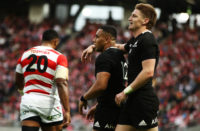 For the second time in six days, Wales went about their business in Cardiff on Friday night in front of more than 25,000 empty seats. Since the autumn series became a four-match annual event against the Southern Hemisphere almost a decade ago, only one fixture – Samoa in 2012 – failed to top 50,000. Now there have been two in a row.
For the second time in six days, Wales went about their business in Cardiff on Friday night in front of more than 25,000 empty seats. Since the autumn series became a four-match annual event against the Southern Hemisphere almost a decade ago, only one fixture – Samoa in 2012 – failed to top 50,000. Now there have been two in a row.
The Argentina attendance dropped to 46,253 – 5,000 fewer than for the same match at the same venue twelve months earlier and 20,000 down on the Springboks the previous week.
Despite further price reductions, the Tongan fixture ended up in the same two-thirds-full, one-third-empty bracket – 46,523. Everything, of course, is relative and what Scotland or Ireland would give for a crowd of that magnitude against second-tier opposition is nobody's business.
Wales, however, are used to a higher barometer of public support, hence the flashing red lights whenever it dips below 50,000. Perhaps the biggest surprise is that it hasn't done so more often.
Years of escalating prices when the cost of watching the national team went up by around 70 per cent made the harsh realities of recessionary times all the more so. That, allied to the sheer amount of Test rugby, has left many Welsh fans no option but to pick and choose their matches.
Understandably, many bought tickets for Australia next week at the expense of Argentina and Tonga. Indications point to 60,000 plus for the Wallabies, a multitude large enough to allay any fears over the enduring appeal of such fixtures.
Even allowing for the Wallabies' match fee of around £750,000, their guarantee for engaging in a Test match outside the three-week period set aside by the IRB, Wales will still make a healthy profit.
When they finish crunching the numbers for the autumn and compare them to seasons past, one set of figures will stick out like the proverbial sore thumb.
Over the same four-week period in November 2005, Wales, the then Grand Slam champions, filled their messianic Millennium Stadium to capacity four weekends on the trot. They had 74,402 for New Zealand, 73,721 for Australia, 73,500 for South Africa and, arguably best of all, 73,045 for Fiji. That added up to a grand total of 294,668, an average of 73,667.
This year they will probably finish around 220,000, an average of 55,000 – marginally down on last year's figure. In other words, over the course of eight years Wales will have lost more than 70,000 paying customers and that spanning a period when the national team has prospered as never before since the Seventies.
There will be many to argue, with some justification, that you can only go to the well so often. As for escalating ticket prices, the penny has finally dropped with the WRU but not before they had hiked the cost of the best seats from £47 to £80 in six years.
Admission charges have been scaled down by around nine per cent for two of the three home matches in the Six Nations. Top prices for the Italy match on February 1 are down from £60 to £55 and for Scotland the following month from £65 to £60.
The reductions are a tacit recognition from the WRU that filling their stadium to its 74,000-odd limit is an increasingly hard sell, that matches against Italy and Scotland are no longer the sell-outs they used to be. Opponents are now given a commercial rating and the prices fixed accordingly.
France, due in Cardiff for another Friday night occasion on February 21, are still considered big enough at the box-office for the top prices to stay at £80. Another sign of the times is that against Australia next Saturday, Wales will not have the field to themselves.
A little earlier that same afternoon, Arsenal will be less than a mile away as the crow flies for a Premier League match against Cardiff City. Its effect on the rugby, if any, will be negligible if only because the 27,500-seater football stadium sells itself out.
Next season, always assuming there is a next Premier League season for Cardiff, they plan to enlarge capacity to nearer 40,000 in which event Welsh rugby could be feeling the pinch all the more.
5 Comments
Leave a Comment
You must be logged in to post a comment.



























Who wants to pay good money to watch fixed matches on a pitch unfit for sheep with substandard/biased Celtic and German officials?
Its a rip off. Only thing to save rugby in Wales is to get the regions in the Aviva Prem
I took my 2 young teenage sons to watch Wales v Samoa at a cost of £240 in the third tier at the millenium
No concession on age !
Pingback: auto swiper
Pingback: บับเบิ้ล